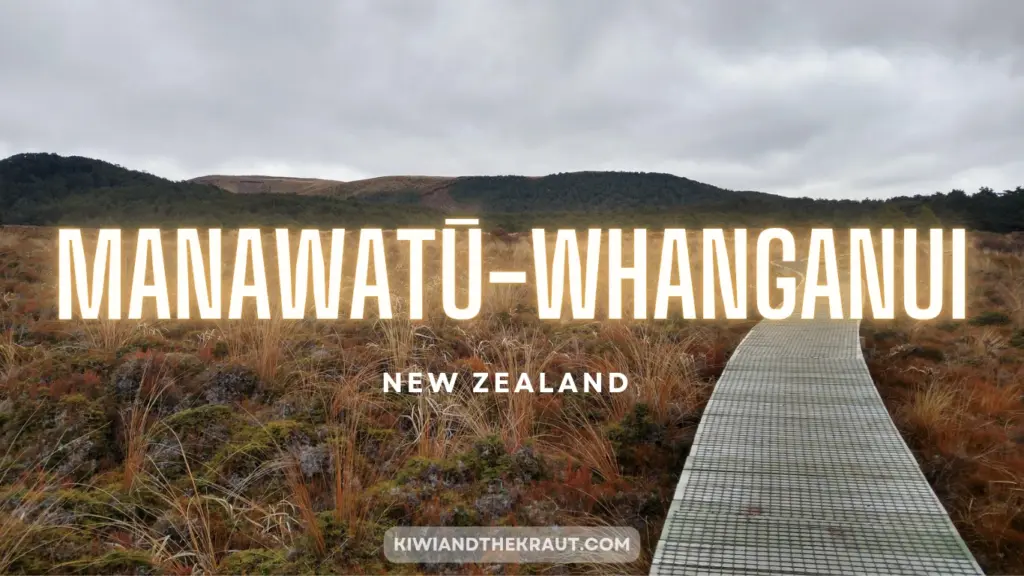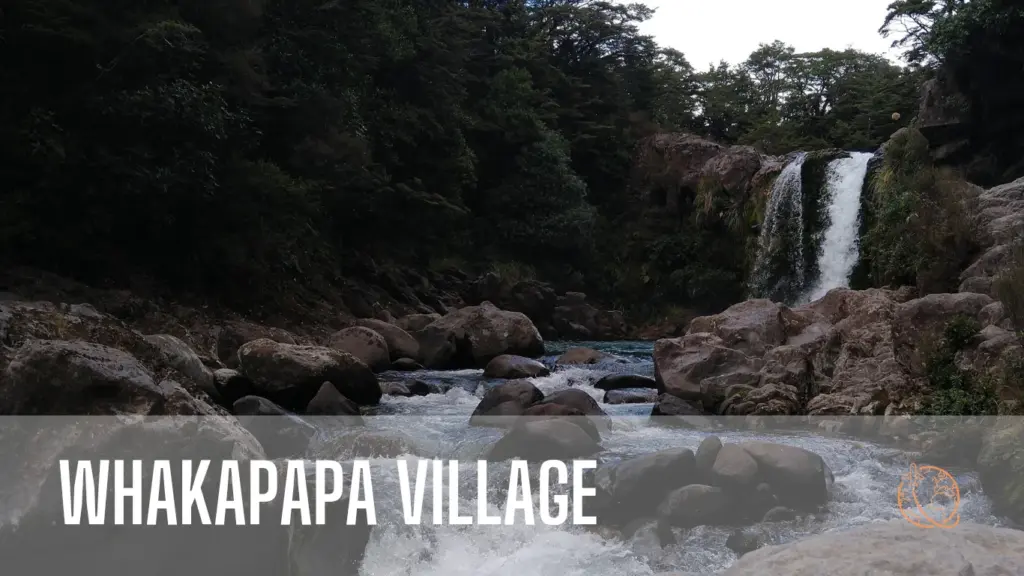
The Manawatū-Whanganui region is the diverse and beautiful region in the lower half of the North Island of New Zealand. It covers a large portion of the centre of the North Island, stretching from the wild Tasman Sea to the vast Pacific Ocean, and includes two major cities: Palmerston North and Whanganui. Manawatū-Whanganui is home to the stunning Whanganui River and the magnificent Tongariro National Park, making it an incredible region for nature lovers to explore!

An Overview of the Manawatū-Whanganui Region of New Zealand
| Manawatū-Whanganui Location: | Lower half of the North Island of New Zealand |
| Bordering Regions: | Taranaki, Waikato, Hawke’s Bay, Wellington |
| Region Size (km2): | 22,215 |
| Population: | 250,400 (Jun 2020) |
| Main Cities and Towns: | Palmerston North, Whanganui, Levin, Fielding |
| Most Popular Tourist Destinations: | Tongariro Alpine Crossing Victoria Esplanade Virginia Lake Timber Trail Durie Hill Elevator Ohakune Old Coach Road |
Highlights of the Manawatū-Whanganui Region of New Zealand
Cities and Towns in Manawatū-Whanganui
Whanganui

The city of Whanganui is located on the west coast of the North Island, along the banks of the stunning Whanganui River. It is a fantastic city to explore, with historic buildings, stunning river views, art galleries, and a thriving farmers market. There are lots of things to do in Whanganui, from strolling around the scenic Virginia Lake Reserve, exploring the Whanganui Regional Museum, and taking the elevator up to the famous Durie War Memorial Tower!
Palmerston North

Palmerston North is a thriving city in the Manawatū-Whanganui region of New Zealand, and is home to the largest campuses of Massey University and the Universal College of Learning. This city is never still, with many awesome events and festivals happening throughout the year! Palmerston North also offers a range of cultural and natural attractions, such as the New Zealand Rugby Museum, the Te Manawa Museum of Art, the beautiful Victoria Esplanade Gardens, and the spectacular Manawatū Gorge. It is surrounded by farmland and rolling hills, and is an excellent base for exploring the Manawatū-Whanganui region.
Bulls

Bulls is a small and charming town near Palmerston North, and should not be missed during your travels through the Manawatū-Whanganui region! It is famous for its humorous signs and puns based on its name, such as “Bulls – a town like no udder” and “Bulls – unforget-a-bull”, as well as several fantastic statues dotted around the centre of town! Bulls has a rural charm and a friendly community, with several historic buildings, antique shops, and cafes.
Mangaweka

Mangaweka is a small town on the banks of the stunning Rangitīkei River, in the northern part of the Manawatū-Whanganui region. It is best known for its adventure tourism, especially rafting and kayaking on the river. Mangaweka also has a rich history and culture, with a heritage main street, a railway museum, and an art gallery. One of the most scenic spots in Mangaweka is by the Mangaweka Camping Grounds, where you can relax by the river and admire the stunning white cliffs surrounding it!
Levin

Levin is the largest town in the Horowhenua District, in the southwestern part of the Manawatu-Whanganui region. It is close to the stunning Lake Horowhenua and Lake Papaitonga, and has several family-friendly attractions – including the Levin Adventure Park, the Bushy Park Wildlife Sanctuary, and the Papaitonga Scenic Reserve. Levin is surrounded by the magnificent Tararua Ranges, so is an awesome base for hiking and hunting enthusiasts looking to explore these wild and remote mountains!
Eketāhuna

Eketahuna is a friendly rural town in the south-eastern part of the Manawatū-Whanganui region, and is a hidden gem! Known as ‘Real Kiwi Country’, it is surrounded by lush native forest and the stunning Makakahi River. It was originally named Mellemskov, meaning “heart of the forest” by the early European settlers! This town may be small, but is bursting with fun things to see – with local cafes, vibrant murals and an early settlers museum to explore!
Places to Visit in Manawatū-Whanganui
Tongariro National Park
The most famous destination in the Manawatu-Whanganui region is the stunning Tongariro National Park. This national park is the oldest in New Zealand, and covers over 780km2 of dramatic volcanic landscape. It is home to 3 active volcanos: Mount Ruapehu, Mount Ngauruhoe, and Mount Tongariro. It is an exciting and remote park to explore, with beautiful alpine bush, walking and hiking tracks, waterfalls, and forests. The park’s most famous hike is the Tongariro Alpine Crossing, which is a one-day trek through some of the most remote and stunning alpine terrain.
Mountains in Tongariro

The mountains in Tongariro National Park are part of the Taupō Volcanic Zone, which extends from White Island in the north to Mount Ruapehu in the south. The three main mountains in the park are Mount Ruapehu, Mount Ngauruhoe, and Mount Tongariro, which are all active stratovolcanoes! Mount Ruapehu is the highest mountain in the North Island, with an elevation of 2,797 m.
Tongariro Alpine Crossing

The Tongariro Alpine Crossing is a spectacular day-hike that travels through the volcanic areas of the Tongariro National Park. It is regarded as one of the best day hikes in the world, and has thousands of visitors every year! The hike starts at the Mangatepopo Valley, and climbs up to the saddle between Mount Ngauruhoe and Mount Tongariro. Along the way, hikers can see the Soda Springs, the South Crater, the Red Crater, and the iconic Emerald Lakes! This hike is best in summer, and takes around 8 hours to complete the 19.4km track.
Whakapapa Village

Whakapapa Village is a charming tourist village in the Tongariro National Park, nestled at the base of Mount Ruapehu. It is the main visitor centre and accommodation hub for the park, and makes for a fantastic base while exploring Tongariro! It has a range of accommodation options, as well as a cafe and restaurant. Whakapapa Village is the starting point for many walks and hikes in the park, such as the Taranaki Falls Track, the Silica Rapids Track, and the Tama Lakes Track. One of the most popular attractions near Whakapapa Village is the iconic Tawhai Falls – a beautiful waterfall made famous as the Lord of the Rings filming location of Gollum’s Pool!
Ohakune

Okakune is a small town at the southern end of Tongariro National Park, close to the southwestern slopes of Mount Ruapehu. Okakune is a popular base in winter for skiers visiting the smooth slopes of Mount Ruapehu, and in summer for trampers hiking the Tongariro Alpine Crossing or exploring the popular Old Coach Road. It has several charming cafes and restaurants, as well as a relaxing spa – perfect for warming up after a day on the slopes! Okakune is known as the Carrot Capital of New Zealand, and you can find some fantastic carrot statues in the town (as well as fresh ones in the shops!)
Outdoor Adventures in Manawatū-Whanganui
Whanganui River

The Whanganui River is the longest navigable river in New Zealand, and flows through the heart of the Manawatu-Whanganui region. It flows south for 290 km from its headwaters in the Tongariro National Park, through the lush Whanganui National Park, to its mouth at the Tasman Sea near Whanganui city. One of the best ways to explore this stunning river is to embark on the Whanganui River Journey, which is a 3 or 5-day canoe trip that carries you down the river, stopping at small settlements and huts along the way. It is a truly unforgettable experience!
Timber Trail
The Timber Trail is an 85 km cycle trail that runs through Pureora Forest Park in the central North Island, as is one of the Great Rides in New Zealand! The trail follows the path of old logging roads and tramlines, linked with purpose
Manawatū-Whanganui Weather
The weather in the Manawatū-Whanganui region is relatively mild and stable, until you get up into the alpine environment of the Tongariro National Park. Here, you can expect snowy and icy conditions during the winter and spring months!

Best Time to Visit the Manawatu-Whanganui Region
Best Time for Hiking in Manawatu-Whanganui
The best time to go hiking or biking in Manawatu-Whanganui is during summer and early autumn (December to March), when the weather is warmer and more stable. During this time, the Tongariro Alpine Crossing is clear of snow and ice, making the track easier and giving you spectacular views!
Best Time for Skiing in Manawatu-Whanganui
The best time to ski on Mt Ruapehu is in the winter months between June and October, when the mountain becomes a winter wonderland and offers some of the best slopes for skiing and boarding in New Zealand.
Airports in the Manawatū-Whanganui Region
Whanganui Airport
The Whanganui Airport is a small airport located just outside the city of Whanganui, and offers daily flights to Auckland by Air Chathams. It is a great airport to use if you are travelling from Auckland to explore Whanganui and the Whanganui National Park.
Palmerston North Airport
The Palmerston North Airport is the main domestic airport in the Manawatu-Whanganui region, and an excellent gateway to the Tongariro National Park and Mount Ruapehu. It offers domestic flights to the Auckland and Christchurch international airports, as well as to Wellington, Hamilton and Nelson.
